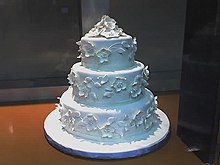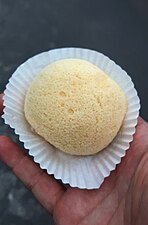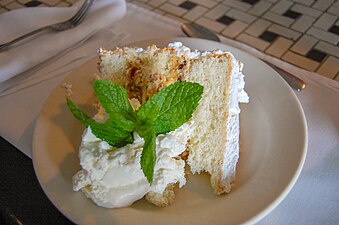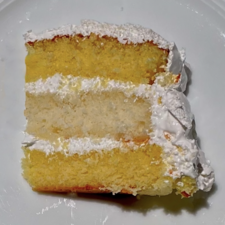White cake
 White cake with white frosting | |
| Type | Cake |
|---|---|
| Course | Dessert |
| Invented | Late 19th century |
| Main ingredients | White sugar, white flour, egg whites, baking powder or baking soda |
White cake is a type of cake that is made without egg yolks. White cakes were also once known as silver cakes.[1]
White cakes can be butter cakes or sponge cakes.[2] They became widely available in the later part of the 19th century, and became associated with weddings and christenings.
Ingredients and techniques
[edit]The key difference between a white cake and others is the absence of egg yolks or other ingredients that would change the color of the cake. (Egg yolks give yellow cake its color.[3]) This decision affects the cake structurally. Because of the lack of egg yolks, the cake has less fat to impede its rise.[3] White cakes tend also to be slightly less tender than cakes made with whole eggs.[4]
White cake typically calls for cake flour rather than all-purpose flour to create a lighter batter with a finer crumb.[3] White cakes are often vanilla-flavored. Sometimes artificial clear vanilla extract is used to preserve the white color.
White cake can be made by the creaming or reverse creaming mixing methods; the latter can be used to make tiered cakes with a tighter crumb that will stand up to stacking.[5][6][7]
Uses
[edit]White cake is a typical choice for tiered wedding cakes because of the appearance and texture of the cake.[4] In general, white baked goods, which used white flour and white sugar, were a traditional symbol of wealth dating to the Victorian era when such ingredients were reliably available, though still expensive.[8] The idea that white symbolizes purity at a white wedding was invented by the Victorians.[9][8]
White cake is used as a component for desserts like icebox cake, and some variations on charlotte russe and trifle.[10][11][12] It is also used as the base for brightly colored cakes, such as a rainbow-colored cake, as the food coloring will produce clearer, brighter colors on white cake batter than if the cake has its own color.[13]
- Examples of white cake
-
Plain Indonesian steamed white cake
-
White layer cake with white frosting and colored sprinkles
-
Lane cake, a white cake with raisin and nut filling
-
White layer cake with frosting
-
Swiss roll, made from white sponge cake
-
Rainbow-colored cakes are usually made from white cake with added food coloring.
-
Silver and gold ribbon cake, with yellow and white cake layers
History
[edit]
White cake is a relatively new invention, as it depends on having refined white sugar and white flour, in addition to omitting the egg yolks.[14] From the 17th century, a "white cake" meant a fruitcake (or other non-white cake) coated with white icing, made from egg whites and expensive double-refined granulated white sugar, rather than a cake that was itself white.[8] Any type of cake coated in white icing, such as the fruitcake served at the 1840 wedding of Queen Victoria and Prince Albert, was expensive and considered a status symbol.[8]
In the early 19th century, a lady cake made of light-colored almond flour, and a tough white sponge cake that was a precursor to the modern, lighter angel food cake, were the only cakes that looked white when cut.[15][16]
Modern white cakes appeared late in the 19th century, when white sugar, white flour, and reliable chemical leaveners such as baking powder became widely available.[14] By the early 20th century, a tall, elaborately decorated white cake, called the bride cake, was established as the primary cake to celebrate weddings, with a dark-colored groom's cake disappearing or taking second place.[14]
The first cake mix for white cake was introduced in the US around 1930.[17]
By the end of the 20th century, chocolate cake had become more popular than any other cake flavor.[16]
Versions
[edit]
- Angel food cake, a sponge cake made using only egg whites[2]
- Lady Baltimore cake, a dish in Southern cuisine[1]
- Mary Todd Lincoln's white almond cake was a celebrated cake during the period surrounding Abraham Lincoln's presidency[18][19][20]
- White velvet cake, a yolkless cake from the 1860s that is a version of Red velvet cake[21]
See also
[edit]- List of cakes
- Foam cake, a style of cake that includes some white cakes
References
[edit]- ^ a b Castle, Sheri (7 August 2022). "The History Behind the Legendary Lady Baltimore Cake". Southern Living. Retrieved 2024-04-14.
- ^ a b "How to Make Angel Food Cake". General Mills.
- ^ a b c Campbell, Annie (21 April 2023). "What's The Difference Between Yellow, White, and Vanilla Cake?". Simply Recipes. Retrieved 2024-04-14.
- ^ a b Prakash, Sheela (10 December 2022). "What's the Difference Between White, Yellow, and Vanilla Cake?". Kitchn. Retrieved 2024-04-14.
- ^ "Cake mixing methods". King Arthur Flour.
- ^ "Tender White Cake". King Arthur Flour.
- ^ "White Cake | Baking Processes | BAKERpedia". American Baking Society. 2016-03-22. Retrieved 2024-04-14.
- ^ a b c d Wilson, Carol (2015). "Wedding cake". In Goldstein, Darra (ed.). The Oxford Companion to Sugar and Sweets. Oxford ; New York: Oxford University Press. ISBN 978-0-19-931339-6.
- ^ Lee, John J. (2022-09-12). "The Victorian-Era Symbolism Behind White-Frosted Wedding Cakes". Tasting Table. Retrieved 2024-04-14.
- ^ The Oxford Companion to Sugar and Sweets. Oxford University Press. April 2015. ISBN 9780199313617.
- ^ Whitehead, Jessup (1891). The American Pastry Cook.
- ^ "Patriotic Berry Trifle". Food Network.
- ^ "How To Make the Ultimate Rainbow Surprise Cake". Kitchn. Retrieved 2024-04-28.
The Best Cake for Rainbow Cake Is White Vanilla Cake: Snow-white cake batter takes readily to a rainbow of hues — no fighting yellow cake's buttery color.
- ^ a b c Woloson, Wendy A. (2013). "Weddings: Wedding Cake". In Smith, Andrew F. (ed.). The Oxford Encyclopedia of Food and Drink in America (2nd ed.). New York, NY: Oxford University Press. ISBN 978-0-19-973496-2.
- ^ Schmidt, Stephen (2015). "Celebration cakes". In Goldstein, Darra (ed.). The Oxford Companion to Sugar and Sweets. Oxford New York: Oxford university press. ISBN 978-0-19-931339-6.
- ^ a b Parham, Sally (2013). "Cake". In Smith, Andrew F. (ed.). The Oxford Encyclopedia of Food and Drink in America (2nd ed.). New York, NY: Oxford University Press. ISBN 978-0-19-973496-2.
- ^ Shapiro, Laura (2015). "Cake mix". In Goldstein, Darra (ed.). The Oxford Companion to Sugar and Sweets. Oxford; New York: Oxford University Press. ISBN 978-0-19-931339-6.
- ^ "Mary Todd Lincoln". National Park Service.
- ^ McCreary, Donna D. (2000). Lincoln's Table: Victorian Recipes from Kentucky, Indiana, and Illinois to the White House. Guild Press of Indiana. ISBN 978-1-57860-089-2.
- ^ "For a taste of history, try Mrs. Lincoln's cake recipe". History News Network. 2007-02-07. Retrieved 2024-04-14.
- ^ Loo, Stephanie (8 February 2024). "White velvet cake is as soft and silky as its name suggests". King Arthur Baking. Retrieved 2024-04-14.
Further reading
[edit]- Wilson, Carol (2005-05-01). "Wedding Cake: A Slice of History". Gastronomica. 5 (2): 69–72. doi:10.1525/gfc.2005.5.2.69. ISSN 1529-3262.







